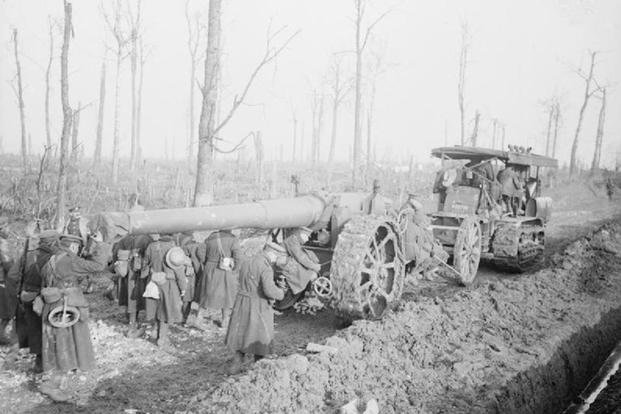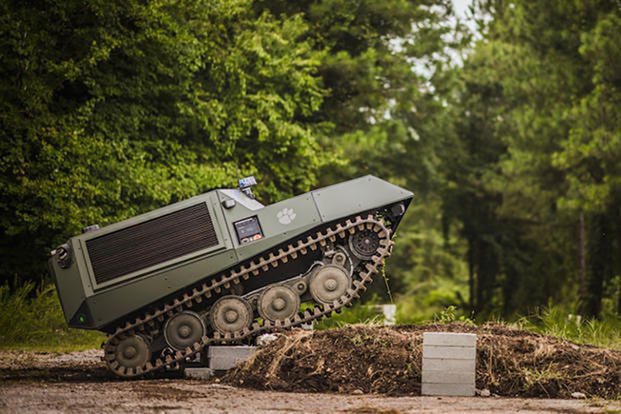As you read this, people at the Pentagon and several civilian partner organizations are putting their heads together to make America’s combat vehicles more effective and efficient through electrification. By combining diesel engines and electric motors, engineers hope to create a way for service members to move in silence and keep mission-critical electronics up and running longer.
The previous generation of military leaders didn’t get it done; neither did the one before that. This isn’t uncharted territory, though. America’s first tank was actually a gas-electric hybrid. It didn’t get past the prototype phase, but it influenced tank development overseas and laid the groundwork for American tankers.
‘America First’ Was Just Plain Silly
During the first months of World War I, it became clear that draft animals would not keep the massive armies supplied with key logistics for long. The battlefield was too dangerous and too difficult to traverse — with feet or hooves.
According to an archived Landships article, the British military turned from Clydesdales and steam-engine tractors to a gas-powered, 15-ton tractor from the Holt Manufacturing Company in the United States. The 75-horsepower Holt Caterpillar tractor (yep, that Caterpillar) could only manage about 5 mph with no weight in tow, but since it had tracks instead of wheels, it could tow heavy artillery pieces through muddy fields better than anything else available.

The tractor also served as the foundation for Britain’s secret weapon: the tank. Holt had minimal involvement other than supplying the tractors for this project, but that didn’t stop the company from cashing in on a perfectly good marketing opportunity.
Tank Encyclopedia notes that the company hastily built a tank of its own for use in local parades in 1916. The beetle-shaped creation roamed the streets of Peoria, Illinois, rather than the battlefield, but it still made a splash in the national news. Fortunately for the designers, photos of the actual tanks hadn’t reached the American public so nobody was any wiser when they saw a glorified grain silo with “America First” painted on the side.

If you look closely at Holt’s “America First” tank, you might have a few questions. How does the crew see where they’re going? For that matter, how did they even get into the tank in the first place? Isn’t that stationary turret a little small for three machine guns? Fair questions, all. Maybe that’s why this prototype ended up being a one-off for local parades.
Behold the Holt Hybrid-Electric Tank

The in-house “America First” prototype was a case of good initiative and bad judgment. Somebody in the U.S. military must have seen promise in the concept, though, because Holt ended up building another prototype for the Army.
An archived Landships article reports that the four-cylinder gasoline engine supplied power not to the tracks, but to a pair of General Electric motors that drove each track independently. This gave the vehicle improved mobility and left enough room at the front of the armored compartment for a Vickers mountain cannon in the nose and a .30 caliber machine gun on either side.
It was a clever idea, but the extra weight of the weapons, armor and powertrain made the tank far too slow and heavy — roughly 25 tons as Landships estimates. That’s a lot for a vehicle with an estimated 90 horsepower.

The U.S. military wasn’t interested in Holt’s hybrid tank, but according to Tank Encyclopedia, Hollywood was. William Randolph Hearst’s International Film Service used a similar design based on the Holt Caterpillar tractor for the weirdly anti-Japanese 1917 miniseries “Patria” (remember, this was more than a decade before hostilities with Japan and right in the middle of a war with Germany, so that’s kind of an odd choice for an on-screen foe). Much of the series’ film has been destroyed or lost, including footage of the tank.
World War I: Proving Grounds for Bizarre Tanks

World War I began with cavalry that traveled on horseback rather than in helicopters, uniforms that looked like formal evening attire, and marching formations that hadn’t changed significantly since the days of flintlock muskets. It ended with chemical weapons, aerial dogfights and tank battles.
As with any new technology, the first tanks to see combat used pretty wild designs.

The most famous examples have to be the instantly recognizable British Mark I through Mark V tanks. These bear a resemblance to (and likely inspired) the fictional Hatay Heavy Tank in the first Indiana Jones movie, “Raiders of the Lost Ark.” The final-form Mark V featured an innovative steering system and a powerful engine, but it had a nasty habit of poisoning the crew with exhaust fumes due to poor circulation.

When Britain began its tank development, France followed suit. According to the Imperial War Museums, the Renault FT was the first tank to feature a rotating gun turret. Other designs of the time relied on multiple gun positions to cover all fields of fire.

Allied advancements caught the German army off-guard. German designers resorted to reverse-engineering destroyed enemy tanks or using capturing ones. As the Tank Museum reports, Germany’s only original tank of World War I was the A7V. It was perhaps a superior design, but the long development phase resulted in only 20 being produced, and they didn’t see combat until 1918.

“Timeline” has a great documentary on the tanks of World War I if you want to really nerd out.
Everything that’s Old Is New Again
More than a century after the failed Holt hybrid tank, the U.S. military is revisiting the concept — this time with much better technology. Oshkosh Defense is already building diesel-electric hybrid versions of the Heavy Expanded Mobility Tactical Truck (HEMTT) and Medium Tactical Vehicle Replacement (MTVR).

The Pentagon is also partnering with Clemson University to develop all kinds of new technology to support tracked vehicles with hybrid powertrains. They’re ostensibly going to be used for disaster relief, but come on. Autonomous tanks are a bit overkill for a pallet of MREs or a pair of stretchers, don’t you think?
Then there’s the possibility of ditching internal combustion altogether. GM Defense is advocating for an all-electric version of the nimble Infantry Squad Vehicle. If fielded, the prototype would give soldiers the speed of a Humvee or JLTV, with the ability to run surveillance systems and charge batteries from the vehicle without a big diesel engine idling in the background. When in motion, the vehicle would produce no more sound than a hushed whir of electric motors and tires rolling across the ground.
It looks like Holt was onto something with its armored tractor hybrid contraption. It just got to the party about 110 years early.
Want to Know More About the Military?
Be sure to get the latest news about the U.S. military, as well as critical info about how to join and all the benefits of service. Subscribe to Military.com and receive customized updates delivered straight to your inbox.
Story Continues
Read the full article here


